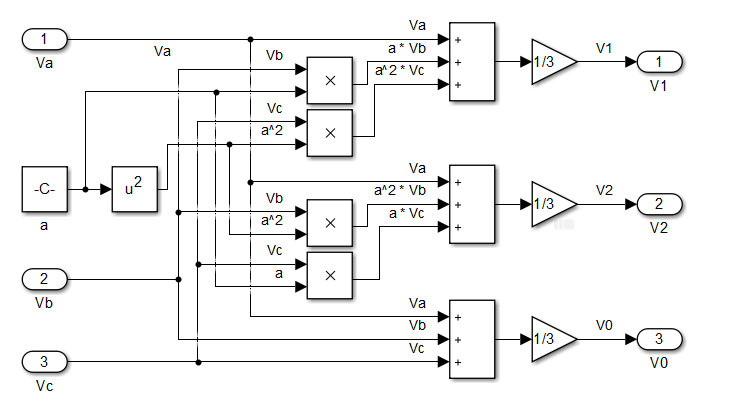Symmetric components are very important parameters used in relay protection to implement protection of various equipment. They allow you to implement more sensitive and specific types of protection.
The essence of the method of symmetrical components has already been shown. Symmetric components are determined from the available phase quantities by the known relations [1]:
![]()
![]()
![]()
where VA, VB, VC – phase voltages or currents; a = exp(j2/3) – rotation operator; V1, V2, V0 – symmetric components of the positive, negative, and zero sequences, respectively.

The implementation of the symmetric component filter in Simulink is given in attached file sym_components.mdl. The type of circuit is shown in Fig. 1.

Fig. 1. The implementation of the symmetric component filter in Simulink
When developing relay protection, the problem often arises of distinguishing symmetrical components not from phase quantities, but from linear, for example, from linear voltages. Using two line voltages, we can distinguish the voltage of the forward and reverse sequences. The zero sequence voltage cannot be distinguished from linear quantities.
Consider how to calculate the direct sequence voltage U1 from the line voltages UAB and UBC. To do this, we need to take into account the following equality:
1 + a + a2 = 0,
where a = exp(j2/3) – rotation operator. This equality is easy to verify with Matlab:
>> a = exp(2i*pi/3); >> 1 + a + a^2 ans = -1.1102e-16 + 3.3307e-16i
We also indicate that linear voltages are associated with phase voltages in the following terms:
UAB = UA – UB,
UBC = UB – UC.
We will use the original formula to calculate the voltage of the direct sequence, taking into account that a = –1 – a2 (the expression is obtained from the equation above):
![]()
![]()
![]()
Similarly, you can derive formulas for the remaining combinations of linear voltages when calculating the voltage of the direct sequence, as well as formulas for calculating the voltage of the negative sequence. The formulas themselves are listed below:
![]()
![]()
![]()
![]()
![]()
![]()
References
- Zeveke G.V., Ionkin P.A., Netushil A.V., Strakhov S.V. Fundamentals of circuit theory. Textbook for high schools. – M .: Energy, 1975.
